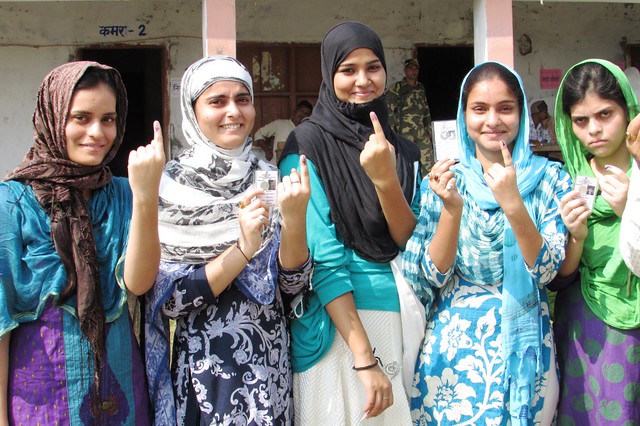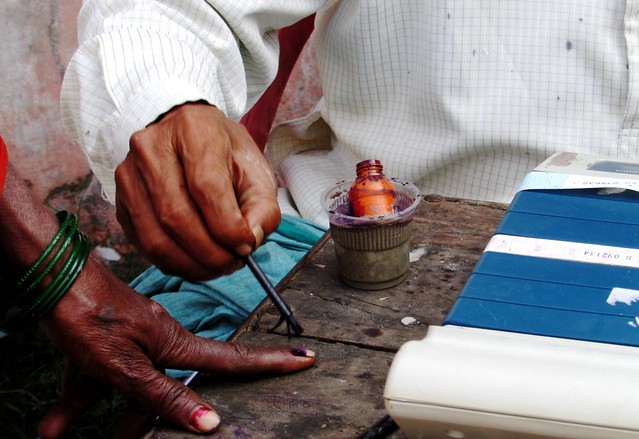By Sharjeel Ahmad
“The day the nation heaved a collective sigh of relief” – this is how The Telegraph (Calcutta edition, dated November 9, 2015) captions the Bihar anecdote that culminated into a decisive, historic, and landslide win for the Mahagathbandhan or the Grand Alliance. Still for many others, like me, the momentous exultation was not just limited to a “mere sigh of relief” though, it was ECSTASY! While party workers could be seen bursting crackers (ironically in India itself), many would go on to celebrate this victory in their own ways. It was also amusing to view the ecstatic effusions on the social media – some remarked the episode as an unprecedented event of how “a cow ate up the BJP,” while still others went to the extent of exclaiming that “India wins freedom the second time!” On second thoughts, the anecdote signifies more about a defeat rather than a victory, a world of a difference between the two, which is what makes me take to penning this assessment.

Was it really a triumph of the secular forces against communalism and fascism? Did Bihar, and India, eventually witness a change in the voting trends after the acute religious polarization and high-headedness being witnessed since the past few months? A big question that must reverberate in the hearts and minds of every Indian who ratifies the might of Constitutional democracy of India; the answer of which is apparently arduous and demanding. A deeper analysis of the election results reveals some disturbing trends, which we would probably not like to apprehend after this much talked about triumph and euphoria.

Going by the party-wise analysis of the distribution of votes, BJP ironically still has the single largest share of votes (a whopping 24.4%) – much larger than any of the constituent parties in the Mahagathbandhan (RJD at 18.4% being the second largest, while JDU standing at 16.8%. Indian National Congress had a much insignificant share of a floundering 6.7%*). The larger factor that needs to be accounted for is the fact that it was more of mathematics, rather than a change in the voting trend, which maneuvered the “so called” popular gambit against the NDA. Yes, by all means, the Grand Alliance under the astute leadership of Nitish Kumar, combined by the refurbishing endeavors and vernacular jibes of Lalu Prasad Yadav, deserves all praises for orchestrating this resonance. Not to forget that this was coupled by the development that the prevailing Nitish regime had meticulously planned and delivered. Had it not been for this astute calculation of the Grand Alliance, the communal forces would have still been at the helm of affairs without much ado. [Let’s forgo some other facts as of now, like the man (Prashant Kishor) who spearheaded the master plan for Modi’s election in 2014 joining hands with Nitish this time in Bihar.]

Unlike the Delhi elections earlier this year, which saw a tussle between three major political wedges, Bihar elections were majorly pitched between two alliances [the entire opposition joining hands together], with a swing in favor of any one being more than expected. In other words, the show was not more than a bi-party phenomenon with some quick political mathematics that went in favor of one coterie. Even what Delhi witnessed in the propulsion of Arvind Kejriwal was akin to a political spring against corruption of the ruling Indian National Congress. More than being a loss for the BJP even then, it was more of a shift of mandate from Indian National Congress to the Aam Aadmi Party (AAP). What eventually called the shots is a unitary conclusion that the political votaries of Delhi were more fed up of the Indian National Congress than being aligned to any specific political acumen of marked significance (as promoted by AAP). So, what Indian National Congress lost in Delhi was gained by AAP, in stark opposition to the seemingly apparent notion of a political spring in the making – note that the Indian National Congress lost its vote share by 14.9% then, while the BJP lost it by a mere 0.8%!
The difference between Delhi and Bihar elections is the fact that while Delhi elections results were more “against” the Indian National Congress rather than being in favor of AAP, Bihar elections witnessed the euphoria of the Grand Alliance based on a carefully crafted political mathematics of the entire opposition joining hands (caste and other factors included) in pitching against the divisiveness of communal forces. Both these elections have the potential of going down the history as jingles of a changing shift in the voter trends apparently – however, the reality is far more disappointing. The evidence of a trivial relegation in the vote percentage of BJP in Delhi and its tall standing with the highest vote share in Bihar eventually culminate around the datum that much contrary to the apparent belief, the Indian polity is defying its hitherto secular stature. The populace, unfortunately, is getting more and more polarized, and is savoring upon a gambit that works best for all the parties. The Rightists have already won India by vociferating in favor of this polarization in the past. The Leftists definitely have a better chance to form coteries that vociferate against the polarization but eventually culminate in consigned mathematical gambits.
The penmanship of this article might appear to target alliances or mathematical gambits apparently; however, it has a far reaching impact on the polity of India. The mathematical gambit is surreptitiously dangerous for the minorities, and the country at large, in so much that the actual welfare of minorities may always tend to take a backseat when the calculations fail at any point. Not to view this as a biased vision from a minority perspective – the repercussions would be a vicious circle where religious divisiveness, polarization and counter polarization would have large grounds to hold and would tend to take a larger toll on the national polity. It then has all the latency of becoming a hotbed for Rightists in a somewhat politically “immature” democracy, which has witnessed affluent polarization equally from all quarters – by the likes of both Sadhvis and Owaisis. Consequently, development and progress would seldom find place in the election manifestoes, which is not a triumph we would be ready to sanction and witness. Evidently; therefore, even though it marks yet another historical peg in the Indian polity, the victory of the Gathbandhan is eventually the celebration of defeat. However, for now, we can rejoice with the hope that development will follow, now that the communal forces have been kept at bay!
*All Electoral References taken from:
http://epaper.telegraphindia.com/paper/1-0-09@[email protected]
https://en.wikipedia.org/wiki/Delhi_Legislative_Assembly_election,_2015
http://www.elections.in/bihar/
…
Sharjeel Ahmad is an MBA from Jamia Hamdard, based in Al Khobar, Kingdom of Saudi Arabia. He is a prolific writer on social, economic, and political aspects of the Indian minorities.

